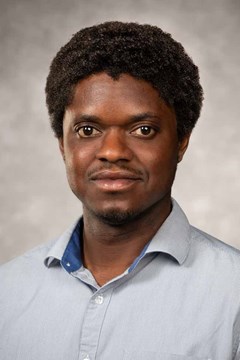Can no-till farming mean lower interest rates for producers?
July 21, 2023
By Ryan McGeeney
U of A System Division of Agriculture
Fast Facts:
- Multiple universities throughout U.S. involved in research
- Division of Agriculture economist Lawson Connor primary investigator for Arkansas
- One goal is to produce online calculation tool for growers, lenders, insurers
(643 words)
(Newsrooms, with photo of Connor)
FAYETTEVILLE, Ark. — Researchers with the University of Arkansas System Division of Agriculture are conducting research examining soil health practices and their impacts on crop risk insurance premiums and other financial factors often faced by farmers.
Lawson Connor, an agriculture economist for the Division of Agriculture, is the primary investigator for Arkansas’ involvement in the research. He is joined by researchers from U.C. Berkley and Rice University.
The funding for the research stems from a $715,611 “Seeding Solutions” grant from the Foundation for Food & Agriculture Research. The foundation’s website describes the annual grant program as funding “audacious research” to address various aspects and challenges of agricultural production. The grant work will is also paired with an AFRI award with titled totaling $800,000 where the University of Arkansas will partner for $175,000. Several family foundations are providing matching funds, bringing the total investment to more than $2.2 million.
Connor said he and other researchers involved in the grant-funded project will be working with available data on cover crop use, crop rotation and no-till or reduced tillage to identify corollaries in higher yields and lower risks to annual crops.
“We’re trying to translate things like yield improvements and risk reduction to financial benefits,” Connor said. “First, by showing that they’re reducing risk, farmers have lower rates of default and should be able to get better loan agreements. Second, given that crop insurance premiums correlate to risk, the price to mitigate that risk should be lower.”
Connor and his fellow researchers will be correlating nearly two decades’ worth of data on Midwestern corn and soybean production. The available data includes information on soil health practices that have been employed, estimated yields, known historical climate and soil data and county-level economic data.
“Much of the crop data is based on satellite detection,” Connor said. “It also contains specific practices, such as tillage rotational complexity and an aim to add cover cropping in the future as well. Then we’re looking at tillage and rotational complexity and how they impacted yields year to year, particularly during events such as really dry years or really wet years — seeing what the different outcomes are for those farms.”
The primary “deliverable” of the research is an online tool that will be available to growers, lenders and insurers to determine how various soil health practices are likely to reduce risk in a given crop.
“Right now, the models are being trained in the Midwest,” Connor said. “We’re starting there because the data were accessible from those regions. But the goal is obviously to increase that footprint nationwide.
“We think that one of the things we’ll be able to see is how these strategies benefit growers from point to point,” he said. “What are the benefits we’ll potentially see, and where do these places not necessarily translate to benefits?”
Connor joined the Division of Agriculture in 2022 and currently serves a three-way appointment, conducting research for the Arkansas Agriculture Research Station, teaching for the Dale Bumpers College of Agricultural, Food and Life Sciences and conducting extension activities for the Cooperative Extension Service. He completed his Ph.D. in economics at North Carolina State University in 2017 and worked as an assistant professor at Louisiana State University from 2018 to 2021.
“How we think about the benefits of some soil health practices is ill-understood,” Connor said. “A lot of what we find is that the benefits don’t translate the same way for everybody — and profits don’t seem to be the most impactful benefit you’re going to get.
“Where we do see a lot of these benefits are with how resilient your farm and land is, especially during times of extreme weather — droughts and extreme moisture conditions,” he said. “When we think about it from a long-term perspective, instead of from a year-to-year perspective, our views change about how we want to incorporate these practices on farms.”
To learn about extension programs in Arkansas, contact your local Cooperative Extension Service agent or visit www.uaex.uada.edu. Follow us on Twitter and Instagram at @AR_Extension. To learn more about Division of Agriculture research, visit the Arkansas Agricultural Experiment Station website: https://aaes.uada.edu/. Follow on Twitter at @ArkAgResearch. To learn more about the Division of Agriculture, visit https://uada.edu/. Follow us on Twitter at @AgInArk.
About the Division of Agriculture
The University of Arkansas System Division of Agriculture’s mission is to strengthen agriculture, communities, and families by connecting trusted research to the adoption of best practices. Through the Agricultural Experiment Station and the Cooperative Extension Service, the Division of Agriculture conducts research and extension work within the nation’s historic land grant education system.
The Division of Agriculture is one of 20 entities within the University of Arkansas System. It has offices in all 75 counties in Arkansas and faculty on five system campuses.
Pursuant to 7 CFR § 15.3, the University of Arkansas System Division of Agriculture offers all its Extension and Research programs and services (including employment) without regard to race, color, sex, national origin, religion, age, disability, marital or veteran status, genetic information, sexual preference, pregnancy or any other legally protected status, and is an equal opportunity institution.
# # #
Media Contact:
Ryan McGeeney
rmcgeeney@uada.edu
@Ryan_McG44
501-671-2120
